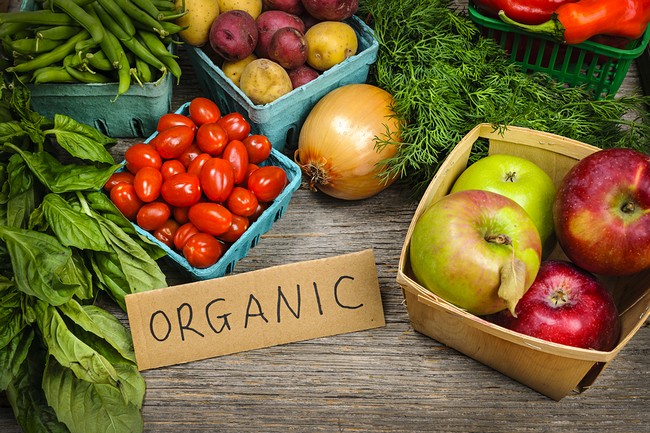- Make It Yourself Lavender Heart-Shaped Bath Bombs!
- 20 Things You Never Knew About “Down There”
- 12 Best Foods For Those Suffering From Arthritis Pain
- 12 Personal Hygiene Mistakes Almost Everyone Makes (Mom Never Told You About #4!)
- 15 Medicinal Plants And Herbs From The Cherokee People
- 12 Mind-Blowing Benefits Of Drinking Coconut Water During Pregnancy
- 12 Outstanding Winter Foods That Won’t Fatten You Up Like A Christmas Turkey
5 Super Easy Ways to Eat Organic on a Budget
Everyone wants to eat organic fruits and vegetables and other items, but once you get to the market and see the prices; well, it makes you want to back off a bit and think twice.
But there are ways to still eat healthy, organic foods and not break the family budget to do so. Here are the top tips for saving money on the healthy organic foods you really want to eat. So check it out and let the savings start!
1. Check websites for coupons as well as special promotions
Almost all supermarkets that sell organic produce have websites with coupons or weekly specials. Whole Foods, for example, has coupons regularly, as does Simply Organic, who makes spices and seasoning mixes. There are many websites that list the coupons available, such as Mambo Sprouts, and HealthEsavers. Plan your meals around the foods that are on sale or that you have coupons for and you can save more than you imagined.
Also, take advantage of the buy one get one free sales or the buy one and get a second at a discounted price. These are great ways to save money. Plan your meals around the extra or freeze and use later, if possible.

Photo credit: bigstock
2. Make Good Use of Your Freezer
Frozen organic produce is almost always cheaper than the fresh produce, so check out the frozen food isle for some savings.
Or freeze your own. Buy local, organic produce when it’s in season and freeze to eat when it’s out of season. Double your recipes and freeze the leftovers for another day. This works great with soups and stews.
If you grow your own produce, you might want to think about learning how to can. Mason jars are inexpensive as they can be used over and over again. Canning is easier than it looks and can save you a fortune in food costs. Almost everyone grows huge amounts of tomatoes, squash, and cucumbers. These freeze or can easily and can be kept for months. Imagine eating your own summer squash in December.
3. Make Use of the Clean and Dirty List
If you haven’t seen it already, check out the Clean 15 and the Dirty Dozen list. This can show you where you can save money if you are really strapped for cash. For example, if you have a choice between the very expensive organic green peppers or the cheaper, but conventional asparagus, it’s safe to buy the asparagus. Asparagus naturally deters pests so it is grown with a minimal amount of pesticides. You can always buy the green peppers when the price comes down. Or you could always grow your own!
SEE ALSO: Top 6 Coffee Alternatives
4. Buy Locally
If you have never been to a farmers market, this is the time to go. You can find one through LocalHarvest.org. You can talk to the farmer’s right there about how they grow their crops. Many farmers grow organically but don’t want to file for the USDA certification that is necessary in order to keep their prices low.
Don’t be the first person at the market; try to go just an hour or two before closing. Many farmers will cut their prices by the end of the day in order to not have to take produce back with them.
You can also buy a share in a community supported agriculture program. In this way you can contribute to local farmers’ expenses and get a weekly box of fresh, organic fruits and/or vegetables. It’s a win-win situation. Read also shocking news about factor farms.
5. Grow Your Own
As you have seen mentioned here several times in this article, one of the best ways to save a ton of money is to grow your own. No matter how little space you have, almost everyone has room for a few pots and that is all that is really needed to grow enough veggies to feed a small family. If you have more space and a large yard, go for it! Plant some fruit trees as well as vegetables.
Once you start growing your own, you will wonder why you didn’t start earlier! You can freeze or can excess or give it away to friends and neighbors. If you are lucky enough to have a few neighbors who are also into gardening, you could set up a veggie swap once a week. You can trade some of your tomatoes for some of your neighbor’s eggplants, for example.
Most vegetable seedlings are very inexpensive (usually less than two dollars) but they will bring you several pounds of vegetables in one season. For example, a seedling 4 pack of bell peppers costs in the neighborhood of $4. However, each plant could produce as many as 10 peppers per season. That would mean about 40 fresh, organic bell peppers for you and your family for a cost of about 40 cents each. Check your supermarket prices on bell peppers. Depending on the season, they can be as much as $2 each. That’s a huge savings for very little effort.
Sources:
































